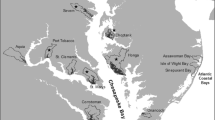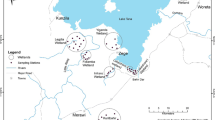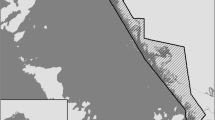Abstract
Cootes Paradise Marsh (CP) is an urban wetland and is part of the Hamilton Harbour Area of Concern (AOC). Anthropogenic stressors have degraded the system’s water quality. Submerged aquatic vegetation (SAV) provides critical fish habitat, and its recovery is crucial to this AOC’s delisting efforts. We developed predictive models to recommend water clarity (Secchi depth) targets that can potentially achieve a minimum SAV presence of 230 ha in CP, using macrophyte monitoring data that have been collected since 1996 by the Royal Botanical Gardens (RBG). A random forest approach was used for modelling SAV presence and SAV % cover. The final model for predicting presence of SAV consisted of Secchi depth, west wind fetch, and water level; the model had high accuracy (accuracy = 0.88, kappa = 0.77). For predicting SAV cover, the final model consisted of water depth, Secchi depth, percent slope, average fetch, water level, and substrate type; it had moderate accuracy (σ2explained = 0.66, root mean square error = 26.09, and weighted absolute percentage error = 58.96). Both models were then applied spatially using a digital elevation model to predict areas of CP where SAV would likely occur under different water level and water clarity scenarios. We recommend a delisting Secchi depth target of greater than 0.75 m to achieve the maximum potential of SAV areal extent under different water level scenarios.

(Map from Court et al., Aquatic plant community monitoring protocol, Royal Botanical Gardens, Burlington, Ontario, 2017, unpublished report [reproduced with permission])






Similar content being viewed by others
References
Anderson MR, Kalff J (1988) Submerged aquatic macrophyte biomass in relation to sediment characteristics in ten temperate lakes. Freshw Biol 19:115–121. https://doi.org/10.1111/j.1365-2427.1988.tb00333.x
Angel J, Kunkel K (2010) The response of Great Lakes water levels to future climate scenarios with an emphasis on Lake Michigan-Huron. J Great Lakes Res 36(2):51–58
Barko JW, Smart RM (1979) The nutritional ecology of Cyperus esculentus, an emergent aquatic plant, grown on different sediments. Aquat Bot 6:13–28. https://doi.org/10.1016/0304-3770(79)90048-2
Barko JW, Gunnison D, Carpenter SR (1991) Sediment interactions with submersed macrophyte growth and community dynamics. Aquat Bot 41:41–65. https://doi.org/10.1016/0304-3770(91)90038-7
Boudreau P, Michel L, Fortin GR (1993) Modelisation hydrodynamique du lac Saint-Pierre, fleuve Saint-Laurent: l’influence de la aquatique. Can J Civ Eng 21:471–489
Bowen K, Theÿsmeÿer T (1998) The cootes paradise fishway: carp control techniques at Royal Botanical Gardens, Hamilton, Ontario, Canada. Hamilton, Ontario
Breiman L (2001) Random forests. Mach Learn 45:5–32
Carpenter SR, Lodge DM (1986) Effects of submersed macrophytes on ecosystem processes. Aquat Bot 26:341–370. https://doi.org/10.1016/0304-3770(86)90031-8
Cedar Lake Ventures Inc (2019) Average weather in Hamilton, Canada. In: Weather spark. https://weatherspark.com/y/19864/Average-Weather-in-Hamilton-Canada-Year-Round. Accessed 4 Dec 2019
Cerco CF, Moore K (2001) System-wide submerged aquatic vegetation model for Chesapeake Bay. Estuaries 24:522–534. https://doi.org/10.2307/1353254
Chambers PA (1987) Nearshore occurrence of submersed aquatic macrophytes in relation to wave action. Can J Fish Aquat Sci 44:1666–1669. https://doi.org/10.1139/f87-204
Chambers PA, Kalff J (1985) Depth distribution and biomass of submersed aquatic macrophyte communities in relation to secchi depth. Can J Fish Aquat Sci 42:701–709. https://doi.org/10.1139/f85-090
Chambers PA, Prepas EE (1988) Undewater spectral attenuation and its effect on the maximum depth of angiosperm colonization. Can J Fish Aquat Sci 45:1010–1017. https://doi.org/10.1139/f88-124
Chick JH, Mclvor CC (1994) Patterns in the abundance and composition of fishes among beds of different macrophytes: viewing a littoral zone as a landscape. Can J Fish Aquat Sci 51:2873–2882. https://doi.org/10.1139/f94-286
Chow-Fraser P (2005) Ecosystem response to changes in water level of Lake Ontario marshes: lessons from the restoration of Cootes Paradise Marsh. Hydrobiologia 539:189–204. https://doi.org/10.1007/s10750-004-4868-1
Chow-Fraser P, Lukasik L (1995) Cootes Paradise Marsh Community participation in the restoration of a Great Lakes Coastal Wetland. Restor Manag Notes 13:183–189
Chow-Fraser P, Lougheed V, Le Thiec V et al (1998) Long-term response of the biotic community to fluctuating water levels and changes in water quality in Cootes Paradise Marsh, a degraded coastal wetland of Lake Ontario. Wetl Ecol Manag 6:19–42. https://doi.org/10.1023/A:1008491520668
Chu C, Minns CK, Moore JE, Millard ES (2004) Impact of oligotrophication, temperature, and water levels on walleye habitat in the Bay of Quinte, Lake Ontario. Trans Am Fish Soc 133:868–879. doi:https://doi.org/10.1577/T03-095.1
Cohen J (1960) A coefficient of agreement for nominal scales. Educ Psychol Meas 20:37–46. https://doi.org/10.1177/001316446002000104
Cohen J (1988) Statistical power analysis for the behavioral sciences, 2nd edn. Routledge, Abingdon
Coops H, Geilen N, van der Velde G (1994) Distribution and growth of the helophyte species Phragmites australis and Scirpus lacustris in water depth gradients in relation to wave exposure. Aquat Bot 48:273–284. https://doi.org/10.1016/0304-3770(94)90020-5
Crosbie B, Chow-Fraser P (1999) Percentage land use in the watershed determines the water and sediment quality of 22 marshes in the Great Lakes basin. Can J Fish Aquat Sci 56:1781–1791. https://doi.org/10.1139/cjfas-56-10-1781
Cutler DR, Edwards TC, Beard KH et al (2007) Random forests for classification in ecology. Ecology 88:2783–2792. https://doi.org/10.1890/07-0539.1
Dale HM (1986) Temperature and light: the determining factors in maximum depth distribution of aquatic macrophytes in Ontario. Can Hydrobiol 133:73–77. https://doi.org/10.1007/BF00010804
Doolittle AGG, Bakelaar CNN, Doka SE (2010) Spatial framework for storage and analyses of fish habitat data in Great Lakes’s areas of concern: Hamilton Harbour geodatabase case study
Duarte CM (1995) Submerged aquatic vegetation in relation to different nutrient regimes. Ophelia 41:87–112. https://doi.org/10.1080/00785236.1995.10422039
Duarte CM, Kalff J (1986) Littoral slope as a predictor of the maximum biomass of submerged macrophyte communities. Limnol Oceanogr 31:1072–1080. https://doi.org/10.4319/lo.1986.31.5.1072
Duarte CM, Kalff J (1990) Patterns in the submerged macrophyte biomass of lakes and the importance of the scale of analysis in the interpretation. Can J Fish Aquat Sci 47:357–363. https://doi.org/10.1139/f90-037
Dugdale TM, de Winton MD, Clayton JS (2001) Burial limits to the emergence of aquatic plant propagules. N Z J Mar Freshw Res 35:147–153. https://doi.org/10.1080/00288330.2001.9516984
Environment Canada, Ontario Ministry of the Environment (2010) Hamilton harbour area of concern status of beneficial use impairments, September 2010
Fleiss JL (1971) Measuring nominal scale agreement among many raters. Psychol Bull 76:378–382. https://doi.org/10.1037/h0031619
Haslam SM (1978) River plants: The macrophytic vegetation of watercourses. Cambridge University Press, Cambridge
Havens KE (2003) Submerged aquatic vegetation correlations with depth and light attenuating materials in a shallow subtropical lake. Hydrobiologia 493:173–186. https://doi.org/10.1023/A:1025497621547
Havens KE, Harwell MC, Brady MA et al (2002) Large-scale mapping and predictive modeling of submerged aquatic vegetation in a Shallow Eutrophic Lake. Sci World J 2:949–965. https://doi.org/10.1100/tsw.2002.194
Hiriart-Baer VP, Milne J, Charlton MN (2009) Water quality trends in Hamilton Harbour: two decades of change in nutrients and chlorophyll a. J Great Lakes Res 35:293–301. https://doi.org/10.1016/j.jglr.2008.12.007
Hudon C, Lalonde S, Gagnon P (2000) Ranking the effects of site exposure, plant growth form, water depth, and transparency on aquatic plant biomass. Can J Fish Aquat Sci 57:31–42. https://doi.org/10.1139/f99-232
International Joint Commission (2016) Regulation plan 2014 for the Lake Ontario and the St. Lawrence River compendium document
Istvánovics V, Honti M, Kovács Á, Osztoics A (2008) Distribution of submerged macrophytes along environmental gradients in large, shallow Lake Balaton (Hungary). Aquat Bot 88:317–330. https://doi.org/10.1016/j.aquabot.2007.12.008
James WF, Best EP, Barko JW (2004) Sediment resuspension and light attenuation in Peoria Lake: can macrophytes improve water quality in this shallow system? Hydrobiologia 515:193–201. https://doi.org/10.1023/B:HYDR.0000027328.00153.b2
Jupp BJ, Spence DHN (1977) Limitations of macrophytes in a Eutrophic Lake, Loch Leven: II. Wave action, sediments and waterfowl grazing. J Ecol 65:431. https://doi.org/10.2307/2259493
Keddy PA (1983) Shoreline vegetation in Axe Lake, Ontario: effects of exposure on zonation patterns. Ecology 64:331–344. https://doi.org/10.2307/1937080
Kelton N, Chow-Fraser P, Jordan I (2004) Relationship between sediment phosphorus release rates and characteristics of the benthic microbial community in a hypereutrophic marsh. Aquat Ecosyst Health Manag 7:31–41. https://doi.org/10.1080/14634980490281218
Kim S, Kim H (2016) A new metric of absolute percentage error for intermittent demand forecasts. Int J Forecast 32:669–679. https://doi.org/10.1016/j.ijforecast.2015.12.003
Lacoul P, Freedman B (2006) Environmental influences on aquatic plants in freshwater ecosystems. Environ Rev 14:89–136. https://doi.org/10.1139/a06-001
Landis JR, Koch GG (1977) The measurement of observer agreement for categorical data. Biometrics 33:159. https://doi.org/10.2307/2529310
Leisti KE, Tang RWK, Doka SE et al (2016a) Bay of Quinte AOC-BUI status report-BUI #14 (FWH-1): degradation of submergent aquatic vegetation (SAV)
Leisti KE, Theÿsmeÿer T, Doka SE, Court A (2016b) Aquatic vegetation trends from 1992 to 2012 in Hamilton Harbour and Cootes Paradise, Lake Ontario. Aquat Ecosyst Health Manag 19:219–229. https://doi.org/10.1080/14634988.2015.1129257
Liaw A, Wiener M (2002) Classification and regression by randomForest. R News 2:18–22
Lougheed VL, Chow-Fraser P (1998) Factors that regulate the zooplankton community structure of a turbid, hypereutrophic Great Lakes wetland. Can J Fish Aquat Sci 55:150–161. https://doi.org/10.1139/cjfas-55-1-150
Madsen JD, Chambers PA, James WF et al (2001) The interaction between water movement, sediment dynamics and submersed macrophytes. Hydrobiologia 444:71–84. https://doi.org/10.1023/A:1017520800568
Middelbøe AL, Markager S (1997) Depth limits and minimum light requirements of freshwater macrophytes. Freshw Biol 37:553–568. https://doi.org/10.1046/j.1365-2427.1997.00183.x
Midwood JD, Chow-Fraser P (2012) Changes in aquatic vegetation and fish communities following 5 years of sustained low water levels in coastal marshes of eastern Georgian Bay, Lake Huron. Glob Chang Biol 18:93–105. https://doi.org/10.1111/j.1365-2486.2011.02558.x
Midwood JD, Tang RWK, Doka SE, Gardner Costa JM (2020) Comparison of approaches for modelling submerged aquatic vegetation in the Toronto and Region Area of Concern. J Great Lakes Res (in press)
Miller SA, Crowl TA (2006) Effects of common carp (Cyprinus carpio) on macrophytes and invertebrate communities in a shallow lake. Freshw Biol 51:85–94. https://doi.org/10.1007/s00198-005-1915-3
Natural Resources Canada (2019) Height reference system modernation. https://www.nrcan.gc.ca/height-reference-system-modernization/9054. Accessed 20 Aug 2019
Randall RG, Minns CK, Cairns VW, Moore JE (1996) The relationship between an index of fish production and submerged macrophytes and other habitat features at three littoral areas in the Great Lakes. Can J Fish Aquat Sci 53(S1):35–44
Scheffer M, Bakema AH, Wortelboer FG (1993) Megaplant: a simulation model of the dynamics of submerged plants. Aquat Bot 45:341–356
Skubinna JP, Coon TG, Batterson TR (1995) Increased abundance and depth of submersed macrophytes in response to decreased turbidity in Saginaw Bay, Lake Huron. J Great Lakes Res 21:476–488. https://doi.org/10.1016/S0380-1330(95)71060-7
Spence DHN (1967) Factors controlling the distribution of freshwater macrophytes with particular reference to the Lochs of Scotland. J Ecol 55:147. https://doi.org/10.2307/2257723
Theÿsmeÿer T, Bowman J, Court A, Richer S (2016) Wetlands conservation plan 2016–2021. Hamilton, Ontario
Thomasen S, Chow-Fraser P (2012) Detecting changes in ecosystem quality following long-term restoration efforts in Cootes Paradise Marsh. Ecol Indic 13:82–92. https://doi.org/10.1016/j.ecolind.2011.04.036
Threader RW, Hodson PV, Cairns VW (1985) The history of Hamilton Harbour and its limnology. Can Tech Rep Fish Aquat Sci 0000:1–144
Vis C, Hudon C, Carignan R (2003) An evaluation of approaches used to determine the distribution and biomass of emergent and submerged aquatic macrophytes over large spatial scales. Aquat Bot 77:187–201. https://doi.org/10.1016/S0304-3770(03)00105-0
Weaver MJ, Magnuson JJ, Clayton MK (1997) Distribution of littoral fishes in structurally complex macrophytes. Can J Fish Aquat Sci 54:2277–2289. https://doi.org/10.1139/f97-130
Werner EE, Gilliam JF, Hall DJ, Mittelbach GG (1983) An experimental test of the effects of predation risk on habitat use in fish. Ecology 64:1540–1548. https://doi.org/10.2307/1937508
Wetzel RG (2001) Limnology: lake and river ecosystems. Academic Press, Cambridge
Wood KA, O’Hare MT, McDonald C et al (2017) Herbivore regulation of plant abundance in aquatic ecosystems. Biol Rev 92:1128–1141. https://doi.org/10.1111/brv.12272
Acknowledgements
We would like to express our gratitude to the Royal Botanical Gardens for providing us with the aquatic plant community monitoring data, specifically to Tys Theysmeyer, Jennifer Bowman, Andrea Court and other field staff who monitored Cootes Paradise. We would also like to thank the Hamilton Harbour–Cootes Paradise, Grindstone RAP sub-committee for their guidance and advice on the project. This research was supported by Fisheries and Oceans Canada (DFO) Great Lakes Laboratory of Fisheries and Aquatic Science (GLLFAS) and the Great Lakes Action Plan (GLAP). Special thanks to Dave Reddick, Jackie Dosen, Janet Jardine, Sarah Day and Cheriene Vierra for their help in the project.
Author information
Authors and Affiliations
Corresponding author
Additional information
Publisher's Note
Springer Nature remains neutral with regard to jurisdictional claims in published maps and institutional affiliations.
Electronic supplementary material
Below is the link to the electronic supplementary material.
Rights and permissions
About this article
Cite this article
Tang, R.W.K., Doka, S.E., Midwood, J.D. et al. Development and spatial application of a submerged aquatic vegetation model for Cootes Paradise Marsh, Ontario, Canada. Aquat Sci 83, 9 (2021). https://doi.org/10.1007/s00027-020-00760-w
Received:
Accepted:
Published:
DOI: https://doi.org/10.1007/s00027-020-00760-w




